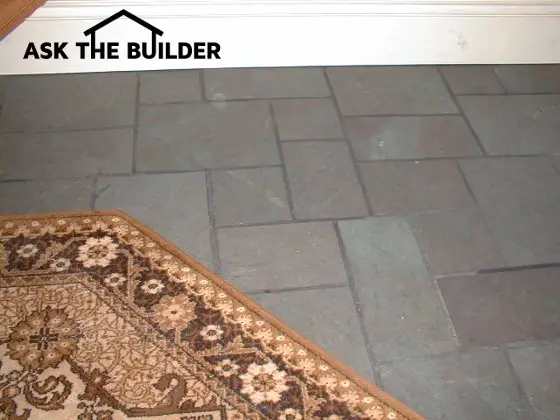Slate Flooring, It’s Great!

DEAR TIM: It's time for new flooring in our entrance hall. I'm considering slate. Do you think slate would make a good floor? Does it stain easily? Are there any special care requirements? Finally, do you feel that this project can be tackled successfully by serious do-it-yourselfers? A. C.
DEAR A.C.: Is this a trick question? I thought everyone knew that slate makes an exceptional flooring material. In fact, my wife selected a magnificent rectangular random ashlar slate flooring for our entrance hall. We receive compliments about it on a regular basis.
Slate is an extremely durable natural stone product. This durability is a byproduct of its origin. Most rocks have a medium or coarse texture. You can see crystals, fossils, or sand grains. Slate is very smooth, somewhat like plastic laminate. Very small silt and clay particles bonded together under high temperature and pressure give slate this monolithic texture. This ultra fine texture makes it tough for liquids (stains) to penetrate slate.
Three unique characteristics set slate apart from other flooring materials: color, texture and available shapes and sizes. Minerals and impurities in the silt and clays create a wide range of colors in natural slate. You can choose from a dark charcoal black, rust red, greens, grays, maroons, and mottled mixtures of these colors.
The most popular texture for flooring is the natural cleft. This surface is moderately rough giving the slate fantastic slip resistance and a unique one-of-a-kind appearance. Slate can be sanded or honed as well. These two finishes are smoother giving the slate a soft sheen look.
I particularly like the different shapes and sizes that are available. You can purchase slate in several thicknesses, one quarter inch being quite popular. This thickness is similar to many ceramic floor tiles. My entrance hall floor is made up of six different size rectangular pieces which interlock into a random looking pattern. You can also purchase square tiles or random irregular pieces that need to be hand trimmed. Large slabs are available for fireplace surrounds, hearths or stair treads.
Slate is very stain resistant. However, some foods can cause stains. You can purchase penetrating sealers that give slate a beautiful 'wet' look but that do not cause a glossy built up finish. Many people make the mistake of applying heavy waxes or floor finishes that rob the slate of its natural beauty and slip resistance.
I feel that slate can be installed by serious do-it-yourselfers. It is installed in a similar fashion as any ceramic flooring material. However, cutting slate must be done with a standard hacksaw or a wet diamond blade saw. You can't score and crack slate like ceramic tile. Also, grouting slate can be very tedious. The natural cleft face can trap the grout. Often professionals coat the slate with special sealers to make grouting an easier task. Take your time, follow directions, and you will have a gorgeous floor.
Column 105